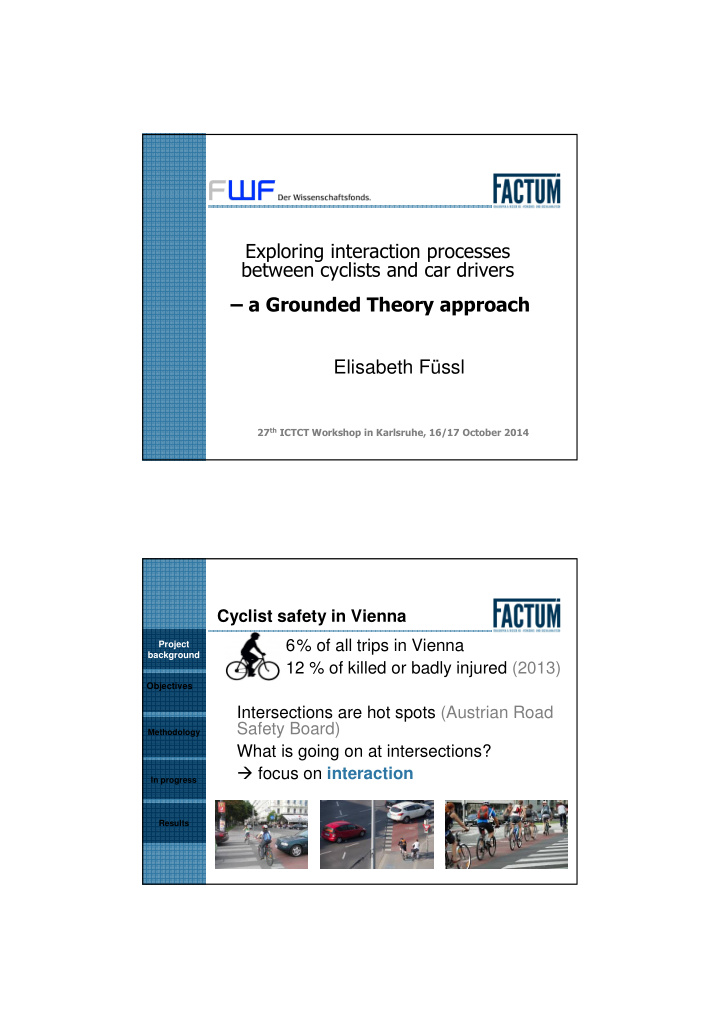



Exploring interaction processes between cyclists and car drivers – a Grounded Theory approach Elisabeth Füssl 27 th ICTCT Workshop in Karlsruhe, 16/17 October 2014 Cyclist safety in Vienna 6% of all trips in Vienna Project background 12 % of killed or badly injured (2013) Objectives Intersections are hot spots (Austrian Road Safety Board) Methodology What is going on at intersections? � focus on interaction In progress Results
Objectives Project background Grounded theory about interaction processes: Objectives Strategies : Identify & collect different forms of interactions and their intention Methodology Interrelations : Identify key factors that influence interaction processes In progress Image & status of cyclists & car drivers as road users: Power relations in road traffic Results Methodology Project Grounded Theory (Glaser/ Strauss 1967) background Objectives Theory-Triangulation Actor-Network-Theory (Callon/Latour 1992) Symbolic Interactionism (Mead/Blumer 1969) Methodology Diamond model (Risser 2000) GADGET matrix (Hatakka et al. 1999) In progress Data triangulation (mixed methods approach) (Creswell & PlanoClark 2008) Results
Overview Methodology Data triangulation Project aims in-depth interviews FGI observation questionnaire → Identify Strategies intentions & forms of interactions further collection & → Explore Interrelations key factors validation validation & hypotheses demonstration of → Value of road users status value Theory triangulation Actor-Network Symbolic → Grounded Theory: Theory Interactionism Diamond model GADGET Matrix Emerge theory about structuring traffic interaction processes mutual process key factors system different levels symbols Data Collection: Interview Project background In-depth interviews with car drivers and bicyclists Objectives Theoretical sampling: Gender / Age / driving Methodology experience (Renge 2000) Work in progress: 6 interviews (3 bicyclists/ In progress 3 car drivers) Results
Data Collection: Observation Project background Video observation on different intersections Objectives 3 cameras, 4 intersections – 100 test drivers, 100 control group drivers Methodology In Analysis: preparation stage category scheme INTERACT Results DC: Questionnaire & Focus groups Project background Standarized questionnaire with bicyclists Objectives after test run Methodology Focus Group discussions with bicyclists / (car drivers?): further data collection Next steps Results
Preliminary results Project Strategies: background Intention of interactions vs. Interpretation of Objectives Interactions intention Methodology Interaction cyclists' view car drivers view arrogance of Next steps saftey margin cyclists ignore red more lights Results comfort, disrespect of rules smooth flow overtaking recklessness tailgating cyclists of car drivers Preliminary results Project background Interrelations: Objectives Self-perception correlates with rule compliance Methodology „ The traffic rules are made for cars. I Next steps understand why cyclists do not resepect those rules.“ (Male cyclist, 20-30) Results
Preliminary results Project background Image & status of road users: Objectives Cycling car drivers seem to have more willigness to „accept“ cyclists on the road Methodology „ Before I started to use the bike myself I used Next steps to overtake cyclists with narrow margin and thought they do not have any right to be on the Results road.“ (Female car driver, 30-40) Project background Thank you Objectives for your attention! Methodology elisabeth.fuessl@factum.at Next steps Results END
Recommend
More recommend